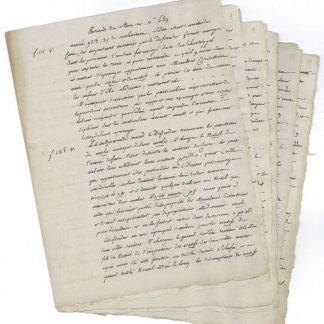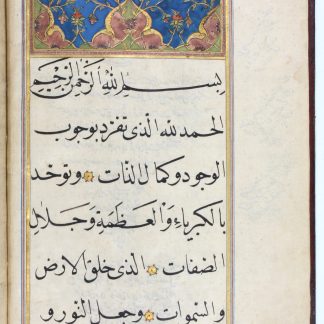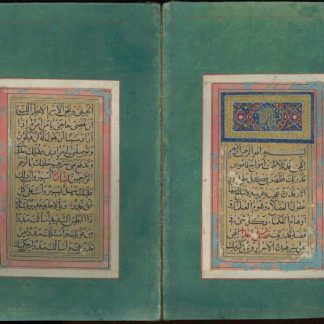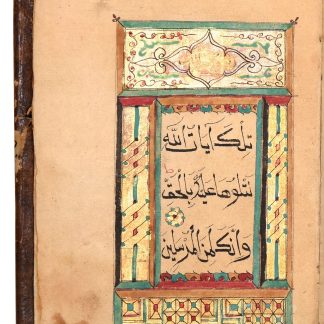"The east and west belong only to Allah": a Chinese Qur'an Juz'
A Chinese Qur'an, Juz' II.
8vo (140 x 226 mm). 48 ff. Arabic manuscript on paper. Black Sini script double-ruled in red, with gold and turquoise verse markers. Opening and closing bifolios thickly bordered in gold, on which is painted patterns in red, turquoise, and black. A few leaves with additional marginal painted knots. 19th century full leather with flap, ruled and stamped in blind.
€ 4,500.00
A complete Chinese manuscript of the second Juz' of the Qur'an, glossed in xiaojing script. Titled in traditional Chinese (perhaps in a later hand) "Di Er Ben" (Second Section), this manuscript is part of the long Islamic manuscript tradition, especially popular among Chinese Muslims, of splitting the Qur'an into thirty sections, called Juz'. Each Juz' would be copied with careful, beautiful Arabic calligraphy.
The second Juz' comprises the greatest portion of the second and longest surah of the Qur'an, Surah al-Baqarah, from verse 142 to 252. Beginning with the story of the adoption of Mecca, rather than al-Aqsa Mosque, as the Qibla of Islam, and closing with precepts on holy war, the second Juz' covers much ground.
Of particular interest in this manuscript are the intermittent glosses, written in what appears to be the uniquely Chinese-Muslim xiao'erjing (or xiaojing) script. The latter is adapted from the Arabic alphabet - with a few Persian borrowings - and is used to write out various dialects of Chinese phonetically. It appears here in an uncommon, vertically-written style in the marginal glosses of the text.
Because xiaojing is famously flexible in adapting to various local Chinese dialects at various points in history, xiaojing manuscript survivals such as this one may serve an historical linguistic purpose: "An in-depth study of xiaojing transliterations carried out with the help of linguists while especially taking into account the unusual graph features may help to reconstruct the Chinese language spoken at the time under scrutiny" (Sobieroj, p. 182). It is indicative, as well, of the diverse ways Muslim communities live and worship across the world.
Paper repairs throughout, remnants of ownership stamps; pages numbered in later ballpoint ink, some light soiling.
Florian Sobieroj, "Standardisation in Manuscripts written in Sino-Arabic Scripts and xiaojing", in: Creating Standards. Interactions with Arabic Script in 12 Manuscript Cultures, ed. by Dmitry Bondarev, Alessandro Gori & Lameen Souag (Berlin & Boston, 2019), pp. 177-216.














